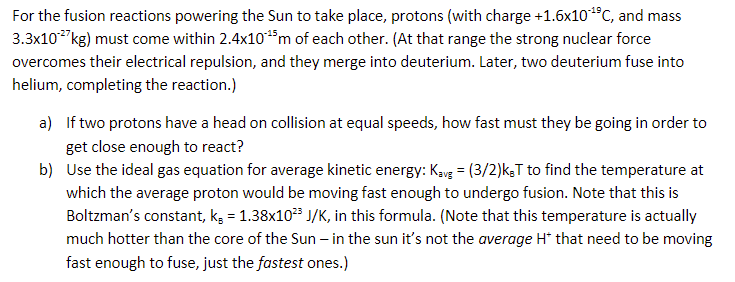For the fusion reactions powering the Sun to take place, protons (with charge +1.6x10¹⁹C, and mass 3.3x10-²7kg) must come within 2.4x10*¹5m of each other. (At that range the strong nuclear force overcomes their electrical repulsion, and they merge into deuterium. Later, two deuterium fuse into helium, completing the reaction.) a) If two protons have a head on collision at equal speeds, how fast must they be going in order to get close enough to react? b) Use the ideal gas equation for average kinetic energy: Kavg = (3/2)kT to find the temperature at which the average proton would be moving fast enough to undergo fusion. Note that this is Boltzman's constant, k, = 1.38x10²³ J/K, in this formula. (Note that this temperature is actually much hotter than the core of the Sun - in the sun it's not the average H* that need to be moving fast enough to fuse, just the fastest ones.)
For the fusion reactions powering the Sun to take place, protons (with charge +1.6x10¹⁹C, and mass 3.3x10-²7kg) must come within 2.4x10*¹5m of each other. (At that range the strong nuclear force overcomes their electrical repulsion, and they merge into deuterium. Later, two deuterium fuse into helium, completing the reaction.) a) If two protons have a head on collision at equal speeds, how fast must they be going in order to get close enough to react? b) Use the ideal gas equation for average kinetic energy: Kavg = (3/2)kT to find the temperature at which the average proton would be moving fast enough to undergo fusion. Note that this is Boltzman's constant, k, = 1.38x10²³ J/K, in this formula. (Note that this temperature is actually much hotter than the core of the Sun - in the sun it's not the average H* that need to be moving fast enough to fuse, just the fastest ones.)
Modern Physics
3rd Edition
ISBN:9781111794378
Author:Raymond A. Serway, Clement J. Moses, Curt A. Moyer
Publisher:Raymond A. Serway, Clement J. Moses, Curt A. Moyer
Chapter14: Nuclear Physics Applications
Section: Chapter Questions
Problem 33P
Related questions
Question

Transcribed Image Text:For the fusion reactions powering the Sun to take place, protons (with charge +1.6x10¹⁹C, and mass
3.3x10-²7kg) must come within 2.4x10*¹5m of each other. (At that range the strong nuclear force
overcomes their electrical repulsion, and they merge into deuterium. Later, two deuterium fuse into
helium, completing the reaction.)
a) If two protons have a head on collision at equal speeds, how fast must they be going in order to
get close enough to react?
b)
Use the ideal gas equation for average kinetic energy: Kavg = (3/2)kT to find the temperature at
which the average proton would be moving fast enough to undergo fusion. Note that this is
Boltzman's constant, k, = 1.38x10²³ J/K, in this formula. (Note that this temperature is actually
much hotter than the core of the Sun - in the sun it's not the average H* that need to be moving
fast enough to fuse, just the fastest ones.)
Expert Solution
This question has been solved!
Explore an expertly crafted, step-by-step solution for a thorough understanding of key concepts.
This is a popular solution!
Trending now
This is a popular solution!
Step by step
Solved in 4 steps with 5 images

Follow-up Questions
Read through expert solutions to related follow-up questions below.
Follow-up Question
Can you please solve this without using calculus? There has to be a way to use the formulas for kinetic energy and potential energy to solve for velocity.
Solution
Knowledge Booster
Learn more about
Need a deep-dive on the concept behind this application? Look no further. Learn more about this topic, physics and related others by exploring similar questions and additional content below.Recommended textbooks for you

Modern Physics
Physics
ISBN:
9781111794378
Author:
Raymond A. Serway, Clement J. Moses, Curt A. Moyer
Publisher:
Cengage Learning

Principles of Physics: A Calculus-Based Text
Physics
ISBN:
9781133104261
Author:
Raymond A. Serway, John W. Jewett
Publisher:
Cengage Learning

College Physics
Physics
ISBN:
9781285737027
Author:
Raymond A. Serway, Chris Vuille
Publisher:
Cengage Learning

Modern Physics
Physics
ISBN:
9781111794378
Author:
Raymond A. Serway, Clement J. Moses, Curt A. Moyer
Publisher:
Cengage Learning

Principles of Physics: A Calculus-Based Text
Physics
ISBN:
9781133104261
Author:
Raymond A. Serway, John W. Jewett
Publisher:
Cengage Learning

College Physics
Physics
ISBN:
9781285737027
Author:
Raymond A. Serway, Chris Vuille
Publisher:
Cengage Learning

College Physics
Physics
ISBN:
9781305952300
Author:
Raymond A. Serway, Chris Vuille
Publisher:
Cengage Learning

College Physics
Physics
ISBN:
9781938168000
Author:
Paul Peter Urone, Roger Hinrichs
Publisher:
OpenStax College

Physics for Scientists and Engineers with Modern …
Physics
ISBN:
9781337553292
Author:
Raymond A. Serway, John W. Jewett
Publisher:
Cengage Learning